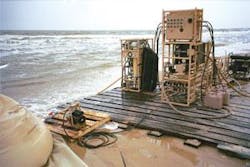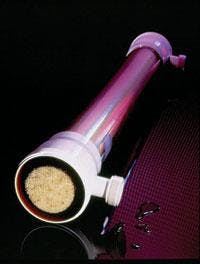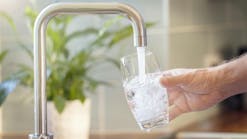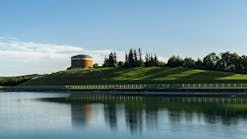The LWP can be transported to any site and produce water in less than 45 minutes for military applications, disaster relief and emergency response.
Click here to enlarge imageThe US Army Tank-automotive and Armaments Command (TACOM) awarded a US$ 40-million contract to the New Orleans-based company MECO to supply its mobile Lightweight Water Purifier units (LWP) that can purify almost any water source during military actions, emergency response and even disaster relief efforts.
MECO provided the first US military portable water treatment systems that desalinated seawater during the Pacific conflict in World War II. In the 1980s MECO manufactured the 600-gph ROWPU, but these systems were heavy, required specialized transport and could not treat all types of water encountered.
The LWP is a highly mobile, reverse osmosis (RO) unit to support company/battalion-size units in the field. Specifications include a potable water production of 125 gph on fresh or brackish water and 75 gph on 60,000 ppm TDS salt water. The system treats highly turbid water containing bacteriological contamination, brackish water, seawater and water contaminated with nuclear, chemical and biological warfare agents.
Military planners are trying to reduce high bottled water costs by treating available water. For example, the US Army predicts the cost of bottled water in the fiscal year of 2005 for troops deployed in Iraq will be US$ 158 million. Bottled water costs approach US$ 5.00 per gallon, and conventional first-generation systems were recently found to cost US$ 1.00 per gallon. The LWP can produce water at US$ 0.07 per gallon, which is primarily the cost of diesel fuel to operate the system and chemicals for minimal, periodic cleaning.
The LWP uses Romipure® hollow fiber ultrafiltration (UF) membranes from Koch Membrane Systems for primary pre-filtration and Fluid Systems® TFC® spiral RO elements to produce potable water from virtually any raw water source. The LWP is comprised of five modules, one Basic Issue Item (BII) box, one Components of End Item (COEI) box, two collapsible fabric water tanks and associated equipment.
LWP process flow
The raw water pump draws water from the source through a strainer into the settling tank. All service pumps are interchangeable. A 1,000-gallon collapsible fabric tank receives the raw water from the water source. Water is then drawn from just below the surface inside the settling tank through a floating strainer. The water is strained through a 200-micron strainer before entering the UF module. A booster pump is used to draw water from the settling tank into the UF module.
The primary function of the UF module is to pre-filter the water before the RO membranes. This is accomplished by means of three 35-mil UF cartridges that can filter suspended particles, bacteria and microorganisms. The cartridges are capable of producing filtrate water with less than 0.1 NTU. The UF membranes offer the advantage of prolonged RO membrane life due to micron size removal, regardless of the feed-water conditions and elimination of disposable filters. The filtrate is then stored in the filtrate tank.
A 40-gallon capacity filtrate tank is attached to the UF module. The purpose of this filtrate tank is to provide filtrate for UF membrane backwash and fast flush while allowing continued operation of the high-pressure pump. Thus, potable water is produced. The backwash pump is used to draw water from the filtrate tank for backwashing operations.




